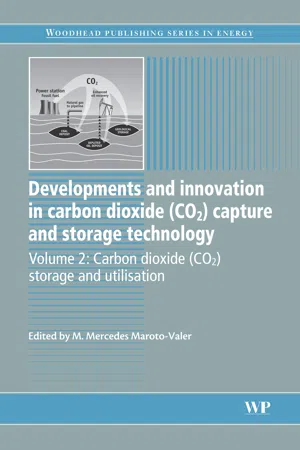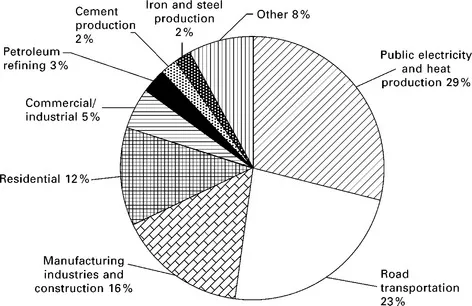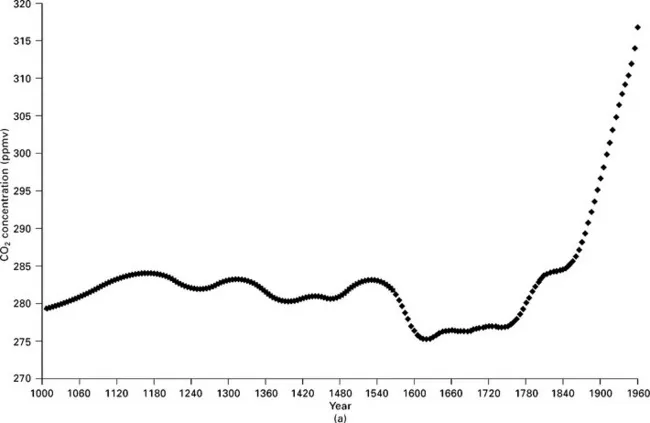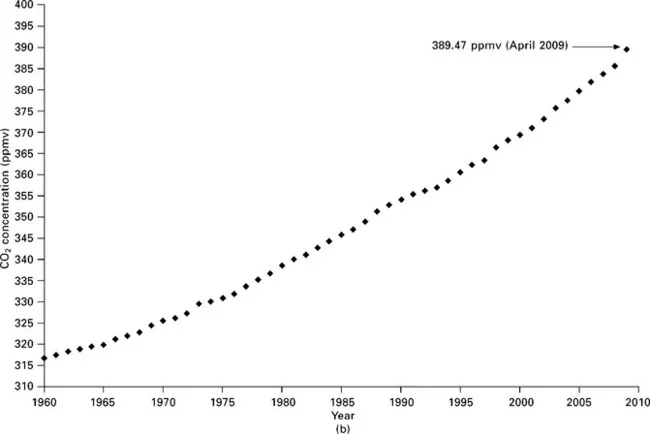
eBook - ePub
Developments and Innovation in Carbon Dioxide (CO2) Capture and Storage Technology
Carbon Dioxide (Co2) Storage and Utilisation
- 544 pages
- English
- ePUB (mobile friendly)
- Available on iOS & Android
eBook - ePub
Developments and Innovation in Carbon Dioxide (CO2) Capture and Storage Technology
Carbon Dioxide (Co2) Storage and Utilisation
About this book
Carbon dioxide (CO2) capture and storage (CCS) is the one advanced technology that conventional power generation cannot do without. CCS technology reduces the carbon footprint of power plants by capturing, and storing the CO2 emissions from burning fossil-fuels and biomass. This volume provides a comprehensive reference on the state of the art research, development and demonstration of carbon storage and utilisation, covering all the storage options and their environmental impacts. It critically reviews geological, terrestrial and ocean sequestration, including enhanced oil and gas recovery, as well as other advanced concepts such as industrial utilisation, mineral carbonation, biofixation and photocatalytic reduction.
- Foreword written by Lord Oxburgh, Climate Science Peer
- Comprehensively examines the different methods of storage of carbon dioxide (CO2) and the various concepts for utilisation
- Reviews geological sequestration of CO2, including coverage of reservoir sealing and monitoring and modelling techniques used to verify geological sequestration of CO2
Frequently asked questions
Yes, you can cancel anytime from the Subscription tab in your account settings on the Perlego website. Your subscription will stay active until the end of your current billing period. Learn how to cancel your subscription.
At the moment all of our mobile-responsive ePub books are available to download via the app. Most of our PDFs are also available to download and we're working on making the final remaining ones downloadable now. Learn more here.
Perlego offers two plans: Essential and Complete
- Essential is ideal for learners and professionals who enjoy exploring a wide range of subjects. Access the Essential Library with 800,000+ trusted titles and best-sellers across business, personal growth, and the humanities. Includes unlimited reading time and Standard Read Aloud voice.
- Complete: Perfect for advanced learners and researchers needing full, unrestricted access. Unlock 1.4M+ books across hundreds of subjects, including academic and specialized titles. The Complete Plan also includes advanced features like Premium Read Aloud and Research Assistant.
We are an online textbook subscription service, where you can get access to an entire online library for less than the price of a single book per month. With over 1 million books across 1000+ topics, we’ve got you covered! Learn more here.
Look out for the read-aloud symbol on your next book to see if you can listen to it. The read-aloud tool reads text aloud for you, highlighting the text as it is being read. You can pause it, speed it up and slow it down. Learn more here.
Yes! You can use the Perlego app on both iOS or Android devices to read anytime, anywhere — even offline. Perfect for commutes or when you’re on the go.
Please note we cannot support devices running on iOS 13 and Android 7 or earlier. Learn more about using the app.
Please note we cannot support devices running on iOS 13 and Android 7 or earlier. Learn more about using the app.
Yes, you can access Developments and Innovation in Carbon Dioxide (CO2) Capture and Storage Technology by M. Mercedes Maroto-Valer in PDF and/or ePUB format, as well as other popular books in Technology & Engineering & Materials Science. We have over one million books available in our catalogue for you to explore.
Information
1
Overview of carbon dioxide (CO2) capture and storage technology
S. Bouzalakos and M. Mercedes Maroto-Valer, University of Nottingham, UK
Abstract:
Carbon dioxide (CO2) capture and storage (CCS) is considered one of the most promising strategies to reduce CO2 emissions while enabling the continued use of fossil fuels and without compromising the security of electricity supply. This chapter first states the global CO2 emissions from power generation and points out that climate change is a serious and urgent issue. The chapter then discusses carbon management options and puts CCS technology into perspective. An account is then given on current plans to deploy large-scale CCS demonstration projects around the world and obstacles that need to be overcome to achieve the current commercialisation target of 2020. Innovation in research, development and deployment is increasingly becoming an important driver of both the mature and developing CCS technologies. This is clearly perceptible throughout the chapters of this book. The chapter closes by offering an outlook of the future trends and recommendations of sources of further information on CCS.
Key words
carbon dioxide
CO2 capture and storage
CCS
climate change
fossil fuels
power generation
1.1 Introduction
Fossil-fuel derived energy presently dominates most aspects of modern human activities and our current way of life, and is projected to remain the main energy source for the foreseeable future. However, the combustion of fossil fuels in stationary and mobile power sources produces large amounts of greenhouse gas (GHG) emissions, including carbon dioxide (CO2) which accounts for approximately 57 % carbon dioxide-equivalent (CO2-eq) of the GHG emissions from fossil fuel use (IPCC, 2007).
CO2-equivalent emission is the amount of CO2 emission that would cause the same time-integrated radiative forcing, over a given time horizon, as an emitted amount of a long-lived GHG or a mixture of GHGs such as, for example, a mixture with methane (CH4) and nitrous oxide (N2O). The equivalent CO2 emission is calculated by multiplying a given emission of GHG by its Global Warming Potential (GWP) for the given time horizon, and for a mix of GHGs the CO2-eq is calculated by summing the equivalent CO2 emissions of each gas. It should be noted that while equivalent CO2 emissions is a standard and useful metric for comparing emissions of different GHGs, it does not imply the same climate change responses (IPCC, 2007).
A recent study by McKinsey & Company (2008) states that approximately 47 % (approximately 2 GtCO2 in 2007) of total European CO2 emissions could be addressed by the application of CO2 capture and storage (CCS) technologies. This includes predominantly large stationary sources, with coal power stations accounting for 52 %. On a global scale, various recent reports estimate that CCS could potentially abate between 1.4 GtCO2 (Stern, 2006) and 4 GtCO2 (IEA, 2007) by 2030. With the increasing energy demand witnessed and projected, already soaring atmospheric CO2 emissions will continue to rise. As CO2 emissions have been unequivocally linked to global warming and climate change (IPCC, 2007), mitigation measures are a matter of urgency.
A range of technologies, collectively termed CO2 capture and storage (CCS), have been identified as a critical option in the portfolio of solutions available to combat climate change, allowing for the reduction of CO2 emissions while enabling the continued use of fossil fuels (IPCC, 2005). CCS involves three main steps: capture, transportation and storage. Overall, the technologies are fairly mature and plans are underway for their large-scale demonstration in the near future. Technological barriers are often a monetary concern, particularly for capture technologies that account for roughly two-thirds of the total cost of CCS. Given the fact that CCS is a relatively new activity for both power plant operators and governments, a suitable regulatory framework has to be put in place to facilitate the wider deployment of the technology. The development and use of CO2 capture technology could take place within existing regulatory frameworks for power stations; however, the main issues for regulation of CCS concern activities offshore, especially geological storage, and transportation.
1.2 Greenhouse gas emissions and global climate change
The greenhouse effect is necessary to sustain life on earth, and in its absence the average temperature on the planet would be around − 18 °C. The major GHGs in terms of total emissions in 2004 were CO2 from fossil fuel use (56.6% CO2-eq), CO2 from deforestation, decay of biomass, etc. (17.3% CO2-eq); methane (CH 4) (14.3% CO2-eq); and nitrous oxide (N2O) (7.9% CO2-eq) (IPCC, 2007). Carbon dioxide is the most important anthropogenic greenhouse gas, even though it is not as harmful as CH4 which is produced from fossil fuel combustion in smaller amounts (IPCC, 2007). Climate scientists have no doubt that the earth’s climate will warm in response to further release of man-made greenhouse gases into the atmosphere by intensifying the greenhouse effect. However, there are uncertainties about the extent of warming that will occur and what the regional impacts of this will be, precisely. To date, the most credible estimation of future climate states comes from mathematical climate models based on physical approximations. Despite uncertainties, all climate models predict substantial climate warming under greenhouse gas increases (IPCC, 2007).
Taking into account the range of human activities, power stations are the largest contributor of anthropogenic CO2 emissions with levels reaching approximately 0.17 GtCO2 in the UK in 2008 (BERR, 2009). This level of CO2 emissions is further emphasised by Fig. 1.1, which shows that approximately 29% of CO2 emissions for 2006 in EU-15 countries were attributed to power generation. According to the International Energy Outlook 2008 (EIA, 2008), the total world energy-related CO2 emissions for 2005 were estimated at 28.1 GtCO2, and are projected to increase by an average of 1.7% per annum from 2005–2030.

Figure 1.1 EU-15 CO2 emissions by source for 2006 (total emissions = 3.46 GtCO2) (EIA, 2008).
Concentrations of atmospheric CO2 have been increasing from approximately 280 ppmv in the pre-industrial era (Fig. 1.2a) to 389.47 ppmv, as measured in April 2009 (Fig. 1.2b). The detrimental effects of increasing CO2 levels on global climate have been well documented, and it is clear that there is a need to reduce CO2 levels (Stocker and Schmittner, 1997; Palmer and Räisänen, 2002; Karl and Trenberth, 2003; Stern, 2006). According to the latest United Nations Intergovernmental Panel on Climate Change (IPCC) report (IPCC, 2007), climate change has been proven to be unequivocally linked to human activity from observations of increases in global average air and ocean temperatures, rising global average sea levels and widespread melting of sea-ice in the Arctic (Fig. 1.3).


Figure 1.2 (a) Average annual atmospheric CO2 concentrations from Antarctic ice and firn from 1010–1960 (Etheridge et al., 1996) (b) Average annual atmospheric CO2 concentrations based on direct measurements at Mauna Loa Observatory from 1960–2009 (Dr Pieter Tans, NOAA/ESRL, www.esrl.noaa.gov/gmd/ccgg/trends).

Figure 1.3 Observed changes in (a) global average surface temperature; (b) global average sea level; and (c) Northern Hemisphere snow cover for March–April (IPCC, 2007).
Despite the increasing atmospheric CO2 concentrations mentioned in the previous paragraph, energy-related CO2 intensities, expressed as emissions per unit of economic output (Table 1.1), have been projected to improve (i.e., decline) from 2005–2030 as world economies strive to use energy more efficiently. Carbon dioxide intensity by non-OECD countries is projected to decline by an average of 2.6% per year, from 529 metric tonnes per milli...
Table of contents
- Cover image
- Title page
- Table of Contents
- Copyright
- Contributor contact details
- Woodhead Publishing Series in Energy
- Foreword
- Chapter 1: Overview of carbon dioxide (CO2) capture and storage technology
- Part I: Geological sequestration of carbon dioxide (CO2)
- Part II: Maximising and verifying carbon dioxide (CO2) storage in underground reservoirs
- Part III: Terrestrial and ocean sequestration of carbon dioxide (CO2) and environmental impacts
- Part IV: Advanced concepts for carbon dioxide (CO2) storage and utilisation
- Index